Delhi: The Ridge
This section was written between 1902 when conditions were Readers will be able to edit existing articles and post new articles |
Contents |
The Ridge in 1902
Extracted from:
Delhi: Past And Present
By H. C. Fanshawe, C.S.I.
Bengal Civil Service, Retired;
Late Chief Secretary To The Punjab Government,
And Commissioner Of The Delhi Division
John Murray, London. I9o2.
NOTE: While reading please keep in mind that all articles in this series have been scanned from a book. Therefore, footnotes have got inserted into the main text of the article, interrupting the flow. Readers who spot these footnotes gone astray might like to shift them to the correct place.
Secondly, kindly ignore all references to page numbers, because they refer to the physical, printed book.
The Ridge is described in detail in Delhi In 1857: The scene of the siege and assault , and only the objects of antiquarian interest, situated on it, will be noticed here. The Lat of Asoka, and the so-called Observatory were situated in the Kushk-i-Shikar, or country palace of Firoz Shah, known also as Jahannuma, or World-displayed, and the Chauburji Mosque probably stood outside that.
[1 The attack on Delhi by the troops of Jaswant Rao Holkar lasted from 7th October to 15th October, 1804: the defence was conducted under Colonel Ochterlony by Colonel Burfn, after whom the Burn Bastion is named. The first attack was made at the south-east angle. After the batteries here had been destroyed by a sally, the curtain between the Turkman and Ajmir Gates was breached, but fresh defences were constructed inside the wall, and no assault of the breach was pressed home. Finally an attack, alao repulsed, was made on the Lahore Gate, a demonstration being made on the Kashmir Gate. Like the actual siege of 1857, which began on 6th September and ended on the 14th, the siege of 1804 lasted for nine days only. The Mahratta forces consisted of 70,000 men and 130 guns; the British force of two battalions and four companies of sepoys, two corps of irregular cavalry, and some 800 Tilangas, who had recently deserted from the enemy; and of these eight companies were lost to the defence, as they were needed to protect the palace and secure the person of the king, whom Holkar desired to get into his own hands. General Lake had ordered that if the city could not be successfully defended, the troops were to retire into the palace and hold that; Colonel Ochterlony wished to do this, but Colonel Burn, who was in military command, refused. The extraordinary achievement of the defence was allowed to pass practically unnoticed, and Colonel Burn never received any recognition of his gallant feat of arms.]
The origin of this palace is thus described by the annalist of the king
In the year 774 H.=1373 A.D., the Wizir Malik Mukbil, entitled Khan Jahan, died, and his eldest son, Juna Shah, succeeded to his office and titles. During the year 776 H., on the 12th of Safar, the king was plunged into affliction by the death of his favourite son, Fatah Khan, a prince of great promise, and the back of his strength was bent by the burden of grief. Finding no remedy, except in patience and resignation, he buried him in his own garden (now the Kadam Sharif, and performed the customary ceremonies upon the occasion. On account of the excess of his grief, the shadow of his regard was withdrawn from the cares of state, and he abandoned himself entirely to his sorrows.
His nobles and counsellors placed their heads on the ground, and represented that there was no course left but to submit to the divine will, and that he should not show further repugnance to administer the affairs of his kingdom. The wise king acceded to the supplications of his friends and well-wishers, and, in order to dispel his sorrows, devoted himself to sport, and in the vicinity of new Delhi he built a wall of two or three parasangs in circumference, planted within the enclosure shady trees, and converted it into a hunting park. The ruins of it remain to this day.
Mr Finch, in the memoirs of his travels as far as Lahore, specially mentions this site in the following terms
A little beyond Delhy are the relicks of a stately hunting house, built by an ancient Indian king, which has great curiosities of stone work about it. Amongst the rest there is a pillar all of one entire stone, some 24 feet high, and as many under ground (as the Indians say), having a globe and half moon at top, and divers inscriptions upon it. This, according to the tradition of the country, a certain Indian king would have taken up and removed, but was prevented in his design by the multitude of scorpions that infested the workmen.
An account of the removal of the Buddhist columns to Delhi will be found on The Lat on the Ridge was broken by an explosion early in the eighteenth century, and lay on the ground for 150 years; and, in consequence, the surface of the stone is rougher, and the letters of the original inscription are less distinct than in the case of the Lat in the Kotila of Firoz Shah, which has stood erect there for 550 years, and no doubt stood erect at Topra for 1600 years.
The Observatory, which stands on the highest point of the Ridge, was in all probability the tower upon which a chiming clock was erected by the king. It is popularly known as the Pir Ghaib, or the Hidden Saint, perhaps from the underground galleries which connected it with the plain to the west, and of which vestiges may be seen throughout the slope on that side. On this side too, near the south corner of the area round Hindu Rao’s house, and at the level of the plain, is a fine baoli, with a very long flight of steps, belonging to the same period as the Kushk-i-Shikar.
Opposite Jahannuma, and probably by the ford under Metcalfe House, Timur and his horde crossed the Jumna in 1398, after taking and destroying Luni, the site of which still rises prominently on the left bank of the river, and after slaying all the captives with the army to a number, it is alleged, of 100,000. At Jahannuma the Moghal camp was attacked by the Sultan, Mahmud Khan, and his minister, Mallu Khan, but the attack was repulsed, and the camp was carefully secured by abattis of trees, and by chaining lines of buffaloes, and placing iron caltrops in front of these, to break the charge of the war elephants.
The Chauburji Mosque, so called from the four domed corner rooms which once stood upon the raised platform, is a structure of the time of Firoz Shah, which was used as a mausoleum, and altered in certain respects in the last century. The restoration, made since 1857, has almost entirely destroyed all resemblance to the building of the Mutiny time.
Encroachments
2019/ 629ha of forest land encroachments
Sep 28, 2019: The Times of India
629ha of forest land on Ridge taken over by encroachers
Over 629 hectares of forest land in Delhi is currently encroached, a reply obtained through an RTI query has revealed. The RTI was filed by environmentalist Akash Vashishtha, revealing that over 12 lakh hectares of forest land had been encroached upon across India at present.
The responses were submitted by the state governments and forest departments of each state and Union territories under RTI, which ranked Madhya Pradesh number 1 with a total encroached forest land of 5,34,717 ha. The response said the primary responsibility of protection of forests lies with the respective state and UT governments. “Hence, the respective state/UT governments fix the responsibility and take action against those who are found guilty in this regard, as per the existent acts, rules and regulations made there under,” said the response.
The reply also stated that the data from 1947, which the activist had sought, was not available as the state of forest report was first published only in 1987. Other questions like the nature of encroachments in forests and the encroachments cleared in the last 20 years did not receive any response.
According to the latest State of the Forest report, 2017, Delhi saw an increase in forest cover from 20.2% to around 20.6% between 2015 and 2017, however the report also highlighted how Delhi had seen a decline in both very dense and moderately dense forest categories. The increase was only in the ‘open’ and ‘scrub’ forest areas.
Delhi’s forest and revenue departments are currently trying to take back encroached land in the Southern Ridge, which is spread over 6200 ha. The action was initiated after a plea was filed in the National Green Tribunal by south Delhi resident Sonya Ghosh and others, alleging encroachments on forest land in the Ridge area and seeking their removal.
A joint status report submitted by the forest department, which TOI has access to, had recently stated that the survey maps for 19 villages — Asola, Bhatti, Chhatarpur, Aya Nagar, Maidangarhi, Satbari, Sahoorpur, Saidulajab, Neb Sarai, Jaunapur, Dera Mandi, Devli, Rajpur Khurd, Tughlaqabad, Pul Pehladpur, Rajokri, Rangpuri, Ghitorni, Mahipalpur — had been prepared and would help depict the exact status of the land, including green areas, encroachment-free land and those falling under Delhi government.
The NGT had rapped Delhi government, forest department and revenue department over delay in demarcation of the Southern Ridge.
As in 2019 Nov
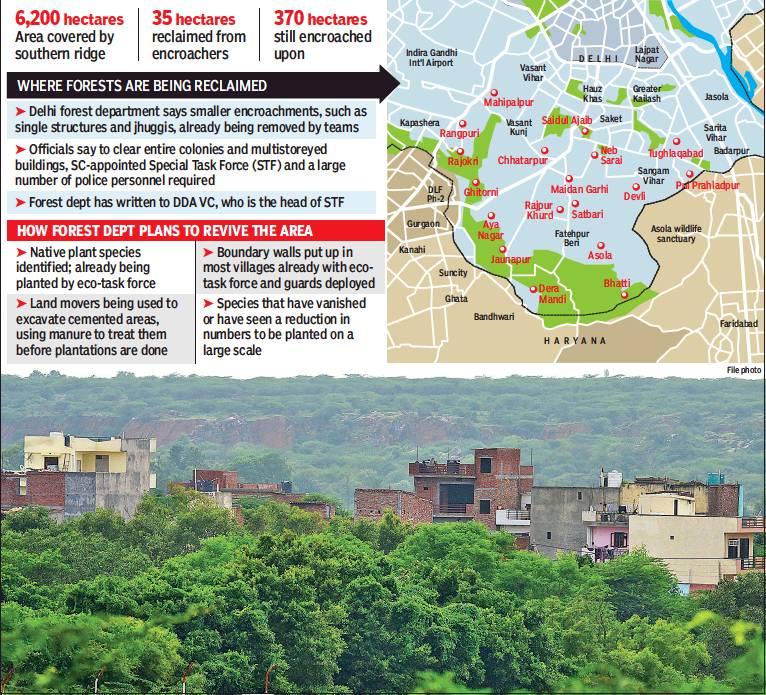
From: Jasjeev Gandhiok, Dec 4, 2019 Times of India
See graphic:
Encroachments on the Delhi ridge, As in 2019 Nov
Loss of forest area
20% of Ridge lost after 1996
The Times of India, June 5, 2016
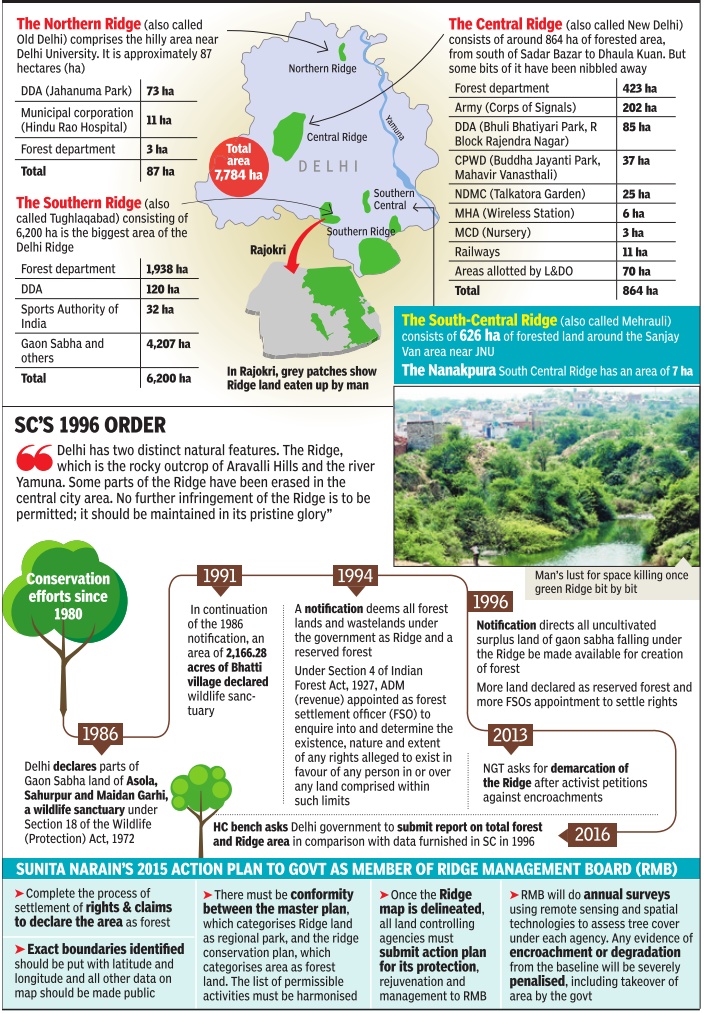
Jayashree Nandi
In spite of being one of the most polluted cities in the world, Delhi's only lung capable of absorbing a part of the emissions remains unprotected. Bit by bit, the urban sprawl is gnawing away at the already disjointed parts of the Delhi Ridge. According to the Delhi forest department's recent estimates, up to 20% of the Ridge may have been lost in the past two decades since the Supreme Court directed that the green belt be protected in its “pristine glory“. The Ridge Management Board (RMB), headed by Delhi's chief secretary, will meet on Monday to discuss the much-needed demarcation of the Ridge.Environmentalists who have been campaigning to save the Ridge claim that successive governments have avoided the issue of demarcating the Ridge because such an exercise involves “tough“ and “unpopular“ decisions like evicting encroachers. The forest department says encroachments existed even before Supreme Court's order in 1996, but they have expanded over the years.
Legally , the Ridge is not a reserve forest. A 1994 notification had intended to declare all forest areas in Delhi, including the Ridge, as reserve forests. However, the demarcation and the settling of land rights leading to a final legal seal of protection was never completed. In 2013, the National Green Tribunal (NGT) gave the forest department six months to issue a final notification after demarcating the Ridge area and settling the rights of people living there. But when the department started demolishing encroachments in Asola in the southern Ridge, the largest Ridge stretch in Delhi, some residents moved the NGT claiming rightful ownership of the land.
Geospatial maps commissioned by the forest department did not tally with the records of the revenue department, and so the chief secretary handed over the demarcation to the revenue department, which is still working on it. Some of the geo-spatial maps now appear on the forest department's website.
Sources in the forest department told TOI that the existing encroachments are expanding even as the revenue department strives to map the area. Not all Ridge residents are poor squatters. Many are rich and powerful and have homes within the Ridge area as recognised by the forest department. An incumbent RMB member said, “It's appalling that people are up in arms when a single tree is cut in the city but aren't bothered about the loss of a large forest.“
The Ridge: a backgrounder
2017
Jayashree Nandi & Jasjeev Gandhiok, August 22, 2017: The Times of India
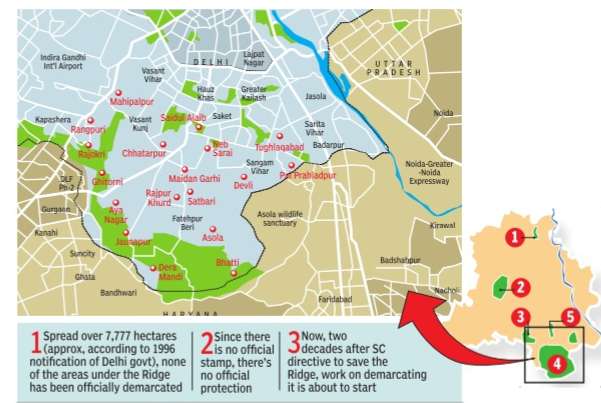



In the 20 years since the Supreme Court ordered the preservation of the capital's green lung, the Ridge, the revenue and forest departments have managed to demarcate just one portion of the sprawling, but much encroached forest land. The revenue department informed the National Green Tribunal on August 11 that it had completed the delimitation of Jaunapur village in the southern Ridge and handed over the land to the forest department for notification.
Officials said this small step still re quired the addition of more portions to the demarcated land before the forest department could begin notifying the expanses as “forest“ area. The exercise is lagging behind the time frame of six months set for the forest department in 2013 by NGT for the final notification of the Ridge and the settling of the rights of people residing within its boundaries. The forest department did begin work in Asola, but the people moved NGT claiming rights to the land. It also came to light that the digitised maps prepared by the two departments did not match.
Apathy by successive governments had left the 7,700-hectare Ridge vulnerable to encroachments, and it is now entangled in litigation. Legally, the Ridge is not a reserve forest. A 1994 notification had intended to declare all forest areas in Delhi, including the Ridge, as reserve forests under Section 4 of the Indian Forest Act. But the demarcation and adjudication of land rights de mands were nev er completed.
R e c e n t l y, exasperated by the inordi nate delay in demarcation, NGT fined Delhi govern ment Rs 2 lakh. “It is regrettable to note that except for taking prevaricated stands on each occasion, the respondents are displaying clear disdainful conduct in frustrating the order of this tribunal,“ the bench said. r In its affidavit filed with NGT on August 10, the revenue department disclosed that the work of demarcating was awarded to a demarcating was awarded to a company in July . “On August 4 and 5, the final handing over of forest land to forest department was done in the presence of the district magistrate (south) and deputy conservator of forests,“ the affidavit stated. The forest department has erected pillars to mark off the forest area.
Officials said portions that appeared encroachment free on satellite maps were selected on priority for demarcation first. After Jaunapur, the revenue department has also completed the delineating of forest land in Pul Pehladpur in the southern Ridge and begun the process in Ghitorni, Rangpuri, Tughlakabad and Rajokri. “The demarcation report along with drawings has been forwarded to the forest department on Au gust 3 for necessary ac tion at their end,“ the revenue department affidavit claimed.
Forest officials revealed that noti fying of the areas as forests can be done only when the chunks were large enough. “Cur rently, we are being handed only small pockets.
Once we get a collectively large area from the revenue depart ment, we will fence it off. We expect a lot of areas to be notified by the end of the year,“ said a senior forest official.
Forest activists, however, are losing patience. Sonya Ghosh, a petitioner in the NGT, pointed out that despite ongoing litigation in the green tribunal, three illegal roads in Rajokri forest were still being used by heavy vehicles. “Forest officials are posted there and yet these vehicles are not stopped. I don't think the forest department has the will to comply with NGT orders,“ fumed Ghosh.
Ghosh alleged that the forest department had detailed maps of the Ridge but ended up demolishing a house that was legally not encroaching on the forest, with the result that the case went to court and stalled the tentative process of marking off the forest area.
Raj Panjawani, Ghosh's advocate in NGT, insisted the government had to take hard decisions. “It's very simple why the process of demarcation is taking so long. It's politics,“ he snapped. “The decision to make the Ridge encroachment free will make some people very unhappy.“
2019: signs of a revival
Jasjeev Gandhiok, WALKING YOU THROUGH RIDGE’S REVIVAL, January 29, 2019: The Times of India
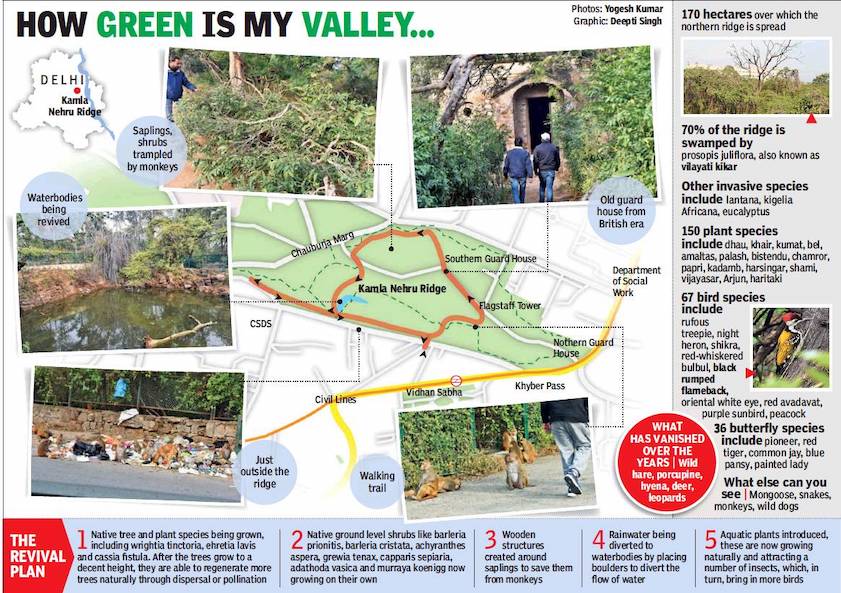
From: Jasjeev Gandhiok, WALKING YOU THROUGH RIDGE’S REVIVAL, January 29, 2019: The Times of India
TOI Takes A Tour Of Northernmost Tip Of The Aravalis To Find Various Invasions, But Revamp Efforts Are Showing Promise
Park visits aren’t routine for most Delhiites. Blame it on work or lethargy or something else, but that’s a fact of life in this big city. Rarer still are walks at biodiversity parks. So, when this reporter got the chance to go for a walk to Kamala Nehru Ridge (or the Northern Ridge), there was no question of saying ‘no’.
The date with nature was set for Sunday, January 27. The northernmost tip of the Aravalis in the capital, nestled cosily among the din and bustle of city life, almost seemed like a different world to us. At 8.30am, TOI entered the Ridge.
Menace of monkeys
The first thing that we noticed, as any other visitor would, were monkeys. Lots and lots of them, sitting on the boundary walls, waiting to be fed. Sure enough, some people obliged them, stopping their cars to hand over fruits and even cooked vegetables, presumably leftovers from the night before. But that wasn’t enough for the entire tribe. Soon, they were busy scavenging garbage dumps nearby.
As we stepped inside the boundary, the main walking trail started. Some people were already turning back from their walk. Some of them came as early as 4am to enjoy peace and solitude that this green lung could offer. But there were more monkeys here, perched on the protective railings on either side. Some were playfully jumping around; others were looking for passersby in the hope of getting something to eat. Regulars here say they are not used to it. But others feel the monkeys are a nuisance.
“I have been coming here since I was a child. Earlier, the wildlife was quite diverse, but nowadays you only bump into monkeys while walking or running. People feeding them only makes them more reliant on us and their population keeps growing,” said Ramesh Chand, a morning walker.
Naren Bhiku Ram Jain, whose father was one of the earliest occupants in Civil Lines, said hyenas and jackals formed part of the Ridge wildlife in the past and people would hesitate to venture into the Ridge. “It has transformed completely, and while it is more people friendly now, the wildlife has vanished,” Jain said.
Off the beaten track, trails of destruction
The main walking trail is wide enough for people to exercise, run or jog. But a kilometre inside, there are narrow trails stretching deeper into the forest. These have been created by over-enthusiastic explorers. The occasional peafowl or peacock can also be seen from afar, but there’s no other wildlife visible. People working on the revival of this part of the Ridge say reducing such trails is the first step to ensure native tree species can grow freely. “These paths are causing segmentation within the forest area. The vegetation growing here gets trampled; and even within a small forested patch, multiple paths only make it difficult for wildlife to survive,” said supervisor Harmeek Singh as he led us deeper into the Ridge.
Another kilometre inside, the air was perceivably cleaner, making breathing less of a struggle. This was quite a departure from the ‘norm’ of air being ‘very poor’ or ‘severe’.
Singh says the problem of human intervention has affected the wildlife to a large extent, but this problem has now been aggravated by monkeys that often destroy new saplings planted.
“Our conservation efforts began in 2015 and each time we plant native trees, they are rarely able to grow up tfo a decent height as the monkeys trample or break them. They don’t do it intentionally, but often cause harm to them while jumping or trying to cross these paths,” said Singh.
Wall trumps growth, but can’t contain green aliens
One gets lost in the abundant greens. But at this point, every second tree one comes across is a vilayati kikar — an invasive species. To counter them, native species like dhua, bel, amaltas, palash, etc, have been planted by their thousands in the last three years. To prevent them from being trampled or destroyed, bamboo or twigs from other trees are now being used to create a dome around a sapling. At other locations, tree guards have been installed to ensure native species can grow to a considerable height.
The dense forest abruptly ends at a wall. Next to it is the road that cuts the Ridge into two. This is segmentation, Singh says, and it’s hurting the Ridge.
“The Ridge is not connected anymore, like it used to be in the past. While animal species could come all the way from Rajasthan to the northern most part here, these corridors have been cut off now with roads built all around. If there are green corridors, animals can simply go to the next patch in search of food without entering human habitation,” he said.
Steep drops greet you when you least expect them. Some are part of the trail, while others are remnants of a past when water used to flow through.
Silent stones speak hope
Old stone structures built by the British and rocks that are millions of years old still stand in silence. The structures have been taken over by monkeys, but occasionally, locals venture here to scribble their names on the walls. The rocks haven’t been disturbed, but the waterbodies are now struggling to cope with almost limitless extraction.
To recharge these aquifers and waterbodies, the slopes of the Ridge are now being used cleverly to divert water back to where it naturally used to flow. “Each monsoon, the water would flow towards Civil Lines and flood the area. But now, we have reversed it so that it flows back into the waterbodies. The groundwater table is increasing. An old serpentine lake called Khooni Jheel which had run dry has now water through the year,” said Arjun, another supervisor. The lake had seen water levels drop by over 10 metres in the last couple of decades owing to groundwater extraction. They have now risen in the last two years.
Professor C R Babu, head of CEMDE, said selective zones are being chosen to provide adequate food for wildlife to return. “Individual trees need to be protected until they can grow to a good height. Unless you bring back the vegetation, wildlife will not return and so that is the first step. Once you have a large mix of native saplings and variety in flora, the fauna will come too,” said Babu, who recalled seeing several jackals a few decades ago.
The trail took us over three hours to complete, though it didn’t feel very long. What we felt was that the Ridge must survive for all of us to have a future.
2021: rejuvenation
Jasjeev Gandhiok, February 12, 2021: The Times of India
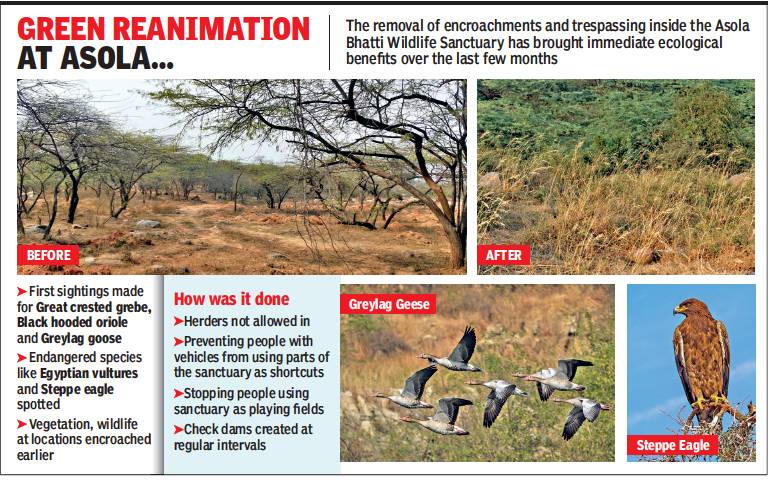
From: Jasjeev Gandhiok, February 12, 2021: The Times of India
The Ridge Is Coming Back! Signs Of Life After Trespassers Thwarted
New Delhi:
The removal of encroachments and trespassers at Asola Bhatti Wildlife Sanctuary is already showing ecological benefits, with officials at the park not only reporting an increase in vegetation growth, but also the sightings of a number of rare birds in the last few months. The sanctuary has recorded the presence of the black-hooded oriole, great crested grebe and greylag geese for the first time, while the endangered Steppe eagle and Egyptian vulture have also been observed at the lake in the park.
The forest department is still carrying out a campaign to rid the Southern Ridge of illegal occupation. While no permanent structures were discovered within the sanctuary, the whole area was suffering on account of trespassers and illegal activities, such as cutting the grass for selling or people entering the protected area to collect firewood. Motor vehicles also drive through the sanctuary, using it as a shortcut.
Amit Anand, deputy conservator of forests (South), who is overseeing the encroachment removal drive in the Southern Ridge, reported the discovery of numerous entry points both on the interior and the exterior of the park, often through deliberate breaches of the boundary walls. Anand said these facilitated the access into the park for trespassers and vehicles.
“There were people playing cricket inside the sanctuary, while villagers, particularly those living nearby, use the park areas as shortcuts. Motorcycles and cars too often enter the sanctuary premises, causing such disturbances that no wildlife is seen in these sections,” said Anand.
Several motorbikes, with cut grass carried on them for sale elsewhere, have been seized. “Firewood collection is another illegal activity that we are focusing on,” disclosed Anand. “However, all other human activities have completely stopped, and this has meant less disturbance for the wildlife inside. Their overall territory under the park’s jurisdiction has, therefore, also increased.”
Sohail Madan, centre manager, Bombay Natural History Society at Asola, claimed that vegetation growth had sped up since trespassing was curbed. There are more wildlife sightings now in places earlier showing human presence. “People earlier cleared the vegetation to use a patch as a cricket field. A number of bikes and cars also passed through the sanctuary, disturbing the habitat. Vegetation growth had stopped and such areas had become barren,” said Madan.
The BNHS manager is happy at the reversal. “We saw a black-hooded oriole for the first time in the park, as also greylag geese and a great crested grebe. Around 15 Egyptian vultures and many Steppe eagles were also sighted at the lake. This is an overall indicator of habitat improvement,” smiled Madan.
A forest officer said plantation had been carried out in some parts of the park, while vegetation had grown back naturally in other locations. “Check dams built in the sanctuary have played a key role in the rejuvenation. The moisture content in the area has increased and you can see grasses growing along the check dams. Water is being preserved and will attract wildlife,” the officer said.
The sanctuary forms a significant chunk of the Southern Ridge and is spread across 1.96 hectares. The sanctuary is a part of the Aravali belt.
Tree species grown
Invasion of vilayati kikar (Prosopis juliflora), subabul (Leucaena leucocephala)
Jasjeev Gandhiok, Delhi Ridge under siege as green alien invades, Sep 17, 2017: The Times of India
Experts Say Mexican Species New Threat After Vilayati Kikar
The Delhi Ridge which is already battling a foreign invader from Mexico -a highly invasive tree species called vilayati kikar (Prosopis juliflora) -may now be up against another tree from the same country . According to Pradip Krishen, environmentalist and author of Trees of Delhi, the green lung of the capital has seen an immense growth of subabul (Leucaena leucocephala), which if unchecked could lead to disaster or the Ridge.
Krishen explained that the tree grows in tough conditions and propagates readily .In the past three years, it has flourished alongside the vilayati kikar and the two invasive species threaten to take over large portions of the Ridge and drastically reduce the space for other species to survive and grow.
“While the species reached Delhi in the 1970s, the spurt in its numbers came in the past few years. Its propensity to spread easily and quickly can prove a disaster for the Ridge and it has to be checked,“ cautioned Krishen, who uproots all subabul saplings he comes across during his morning walks with his dogs.
The tree expert pointed out that a similar problem had occurred at the Delhi Golf Club, where subabul was planted for its fast growth, but had soon colonised a large area. “They grow quickly , and fully grown you cannot chop them down without the permission of the forest department,“ Krishen added.
The species was chosen for its farm-forestry utility in 1970 for its quick growth and usefulness as cattle feed. In time, experts across the country soon discovered its invasive nature.The leaves could also prove toxic if consumed in large quantities by cattle, experts said.
Faiyaz A Khudsar, scientist in-charge at the Yamuna Biodiversity Park, however, feels while the subabul may be thriving and increasing at a fast pace, it isn't too late to control its spread. “Subabul's properties are different from vilayati kikar's in the sense that it does not degrade the environment like the latter does,“ argued Khudsar. “Yes, it grows very quickly and has shown a spike in numbers, but a systematic action plan can be made to tackle its unchecked spread.“
The forest department will focus on reviving the Central Ridge this year after the Delhi government's budget earmarked Rs 50 lakh for the cost of ridding the green expanses of vilayati kikar. Forest officials say a patch will initially be chosen for the replacement of kikar with native species. Indian trees considered to have the highest rate of survival will be chosen.
Unauthorised colonies
1996, 2013-18
Jayashree Nandi, Fresh threat looms over Delhi Ridge, August 1, 2018: The Times of India
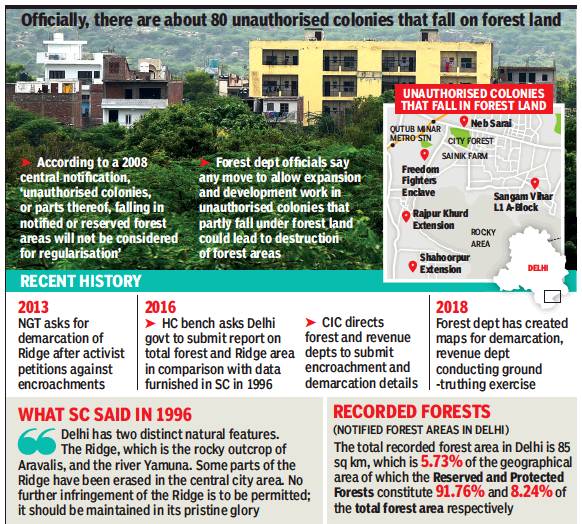
From: Jayashree Nandi, Fresh threat looms over Delhi Ridge, August 1, 2018: The Times of India
Plan To Allow Expansion Work In Illegal Colonies
The government is planning to allow expansion and development work in the unauthorised colonies that fall under forest land — mostly in Delhi Ridge area.
On Monday, the government held a meeting with the urban development department, Delhi Development Authority (DDA) and the forest department on regularisation of these colonies, including those that fall under forest land. However, the forest department officials who have verified the location said such a decision could lead to destruction of forest areas and proliferation of unauthorised colonies in the Ridge, which is already vulnerable.
“We have asked the forest department whether development work can be taken up in areas that are partly falling under it and are waiting for a formal reply. Most of these colonies fall both in forest and non-forest lands. The decisions have to be taken on a case-by-case basis,” Rajiv Yudhavanshi, principal secretary, urban development told TOI.
However, a senior forest official said, “We have not been asked anything as yet by the urban development department. There are about 80 unauthorised colonies that fall on forest land.
The formal demarcation of these land and revenue is, however, being done by the revenue department on the ground.”
A forest department official also pointed out that the decision to allow expansion work is in violation of a 2008 Central notification on rules for regularisation of unauthorised colonies in Delhi. The notification states that unauthorised colonies or parts thereof falling in notified or reserved forest areas will not be considered for regularisation. The Forest Conservation Act guidelines also state that development works on non-forest land cannot be started when a project involves forest and non-forest lands unless the central government approves release of land involved.
The Delhi high court and National Green Tribunal had asked the government to demarcate the Ridge area to secure whatever is left of the green lung covering nearly 8,000 hectares in different parts of the city from encroachments.
Central Information Commission in 2016 had directed both forest and revenue departments to furnish details of encroachments and the status of demarcation of the Ridge area to secure it from further encroachment. But this process is yet to be completed.
The unauthorised colonies that fall under forest land include Sangam Vihar L1 ABlock, Rajpur Khurd Extension, Neb Sarai Extension, Freedom Fighters Enclave in Neb Sarai and Sahurpur Extension, among others.
See also
Delhi: Flora, forests: important
Delhi: The Ridge